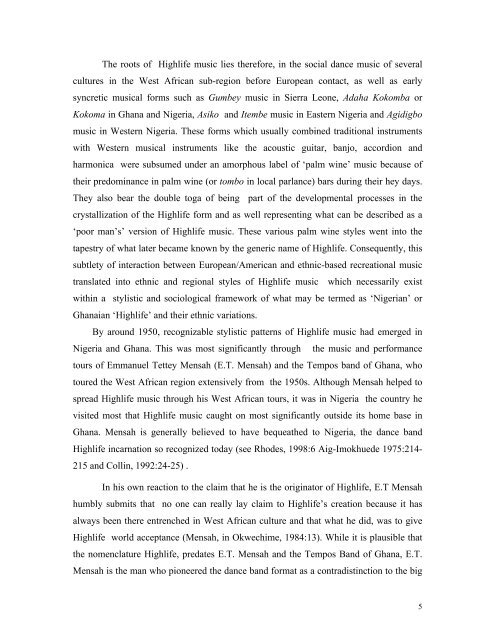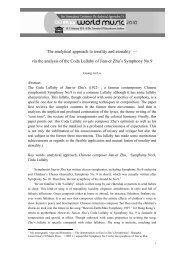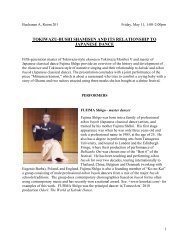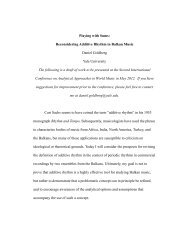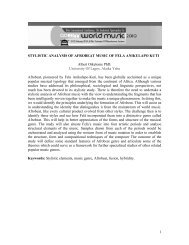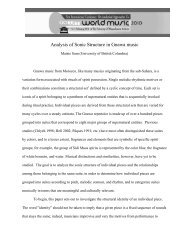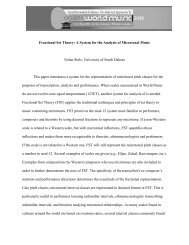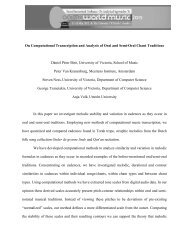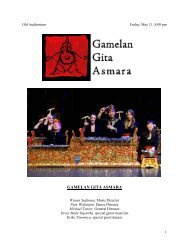A Case Study of Highlife Music - Analytical Approaches to World Music
A Case Study of Highlife Music - Analytical Approaches to World Music
A Case Study of Highlife Music - Analytical Approaches to World Music
You also want an ePaper? Increase the reach of your titles
YUMPU automatically turns print PDFs into web optimized ePapers that Google loves.
The roots <strong>of</strong> <strong>Highlife</strong> music lies therefore, in the social dance music <strong>of</strong> severalcultures in the West African sub-region before European contact, as well as earlysyncretic musical forms such as Gumbey music in Sierra Leone, Adaha Kokomba orKokoma in Ghana and Nigeria, Asiko and Itembe music in Eastern Nigeria and Agidigbomusic in Western Nigeria. These forms which usually combined traditional instrumentswith Western musical instruments like the acoustic guitar, banjo, accordion andharmonica were subsumed under an amorphous label <strong>of</strong> ‘palm wine’ music because <strong>of</strong>their predominance in palm wine (or <strong>to</strong>mbo in local parlance) bars during their hey days.They also bear the double <strong>to</strong>ga <strong>of</strong> being part <strong>of</strong> the developmental processes in thecrystallization <strong>of</strong> the <strong>Highlife</strong> form and as well representing what can be described as a‘poor man’s’ version <strong>of</strong> <strong>Highlife</strong> music. These various palm wine styles went in<strong>to</strong> thetapestry <strong>of</strong> what later became known by the generic name <strong>of</strong> <strong>Highlife</strong>. Consequently, thissubtlety <strong>of</strong> interaction between European/American and ethnic-based recreational musictranslated in<strong>to</strong> ethnic and regional styles <strong>of</strong> <strong>Highlife</strong> music which necessarily existwithin a stylistic and sociological framework <strong>of</strong> what may be termed as ‘Nigerian’ orGhanaian ‘<strong>Highlife</strong>’ and their ethnic variations.By around 1950, recognizable stylistic patterns <strong>of</strong> <strong>Highlife</strong> music had emerged inNigeria and Ghana. This was most significantly through the music and performance<strong>to</strong>urs <strong>of</strong> Emmanuel Tettey Mensah (E.T. Mensah) and the Tempos band <strong>of</strong> Ghana, who<strong>to</strong>ured the West African region extensively from the 1950s. Although Mensah helped <strong>to</strong>spread <strong>Highlife</strong> music through his West African <strong>to</strong>urs, it was in Nigeria the country hevisited most that <strong>Highlife</strong> music caught on most significantly outside its home base inGhana. Mensah is generally believed <strong>to</strong> have bequeathed <strong>to</strong> Nigeria, the dance band<strong>Highlife</strong> incarnation so recognized <strong>to</strong>day (see Rhodes, 1998:6 Aig-Imokhuede 1975:214-215 and Collin, 1992:24-25) .In his own reaction <strong>to</strong> the claim that he is the origina<strong>to</strong>r <strong>of</strong> <strong>Highlife</strong>, E.T Mensahhumbly submits that no one can really lay claim <strong>to</strong> <strong>Highlife</strong>’s creation because it hasalways been there entrenched in West African culture and that what he did, was <strong>to</strong> give<strong>Highlife</strong> world acceptance (Mensah, in Okwechime, 1984:13). While it is plausible thatthe nomenclature <strong>Highlife</strong>, predates E.T. Mensah and the Tempos Band <strong>of</strong> Ghana, E.T.Mensah is the man who pioneered the dance band format as a contradistinction <strong>to</strong> the big5


